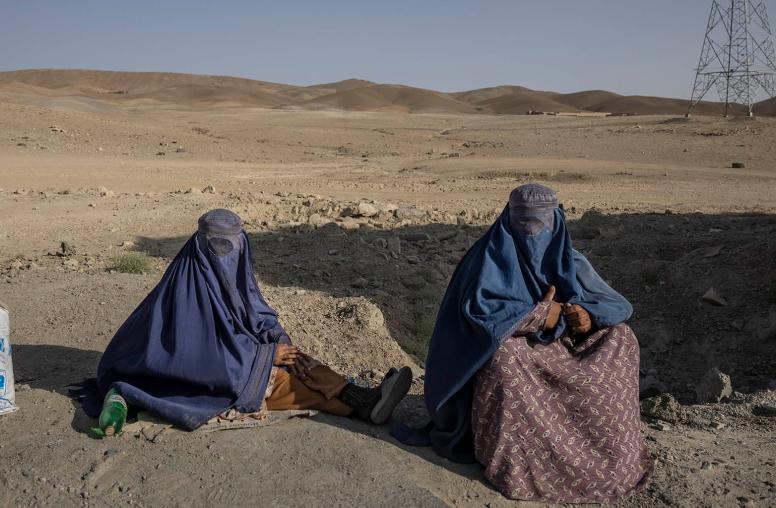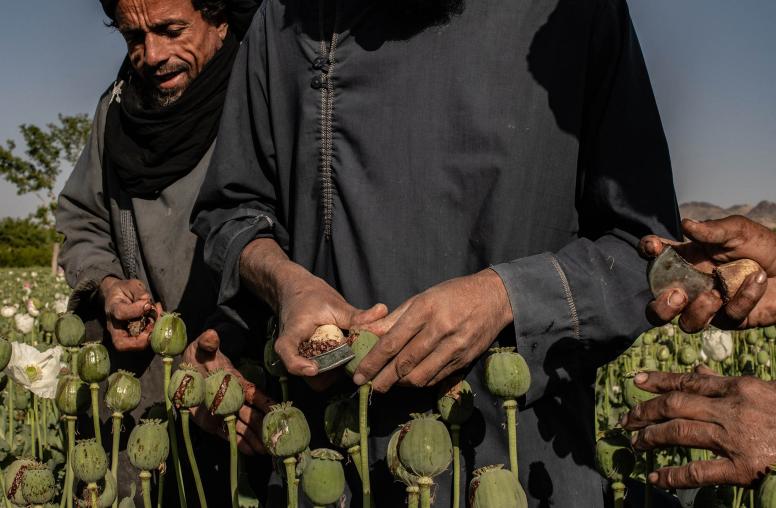Can Afghanistan Reap a Peace Dividend if Taliban Talks Succeed?
What the economics of building and sustaining peace look like in the war-torn country.
In recent months there has been a flurry of movement in the Afghan peace process, leading to talk of a “peace dividend” that would boost the country’s economy and incentivize and sustain peace. For example, the November 2018 Geneva international conference on Afghanistan called for donors and development and regional partners to develop a post-settlement economic action plan. But what would a peace dividend look like in war-torn Afghanistan? In the short run, could it help incentivize the insurgency and state actors to agree and adhere to a peace agreement? And in the longer term, could it help sustain peace and lead to a more prosperous and stable Afghanistan?

What is a Peace Dividend?
Although there are varying definitions, the term originally referred to the budgetary savings from lower military spending after the end of a war and the consequent increase in public expenditures on domestic priorities. In the long term, this kind of peace dividend indeed can be significant provided that military spending actually declines and translates into increases in civilian expenditures. Afghanistan incurs extremely high security costs amounting to as much as a quarter of the country’s Gross Domestic Product (GDP), which should decline greatly if there is peace. However, the country’s extremely high aid also would decline at least gradually under a peace scenario, reducing the scope for this kind of peace dividend.
A second, narrower definition is an infusion of aid or other cash inflows accompanying a peace agreement or peace process, intended to reward the participants and/or segments of the wider population. An immediate peace dividend of this kind would signal change and help restore confidence, and consolidating peace requires shifting the incentives of important actors away from violence. At one end of the spectrum, this can involve political pay-offs and distribution of resources to leaders of different armed factions, at the other expenditures and investments aimed at larger segments of the population. However, overly high expectations regarding immediate increases in employment and improvements in living standards are likely to be disappointed, leading to disenchantment and possibly greater risk of relapse into conflict.
A third, broadest definition of the peace dividend is that durable cessation of conflict, accompanied by some level of political stability, can lead to a post-conflict economic boom. This typically represents “catch-up” economic growth after a period of substantially depressed growth during a protracted conflict. A key question is how to sustain a post-conflict growth spurt, which in most countries have not lasted.
The ingredients of a post-conflict economic boom tend to be somewhat similar across countries: 1) a revival of aggregate demand along with improved confidence and a boost in investment; 2) an increase in the labor force with return of refugees, displaced persons, and ex-combatants; and 3) reversal of capital flight. Agriculture typically is a major source of catch-up growth in the aftermath of conflict; rebuilding of destroyed and deteriorated infrastructure leads to a construction boom; and mineral extraction may be a growth driver in countries that are well-endowed.
Afghanistan’s Post-2001 Economy
Afghanistan’s experience in the early post-2001 period, when it underwent its own “post-conflict” economic boom after the military victory over the Taliban, echoes some of these international patterns. Millions of Afghan refugees and migrants returned, Afghan private capital was repatriated, construction boomed, and agriculture recovered from the severe drought of the late 1990s, becoming a major contributor to economic growth.
Despite the resumption of widespread conflict during the second half of the 2000s, continuing rapid but unsustainable economic growth was fueled by an influx of international military expenditures and aid, peaking during the 2009-2011 “surge.” Then the U.S. troop drawdown sharply contracted international military expenditures in-country, precipitating a severe recession that has persisted to this day. Economic growth has fallen behind or at best has barely kept up with Afghanistan’s rapid population growth.
Overall, Afghanistan still lags far behind other countries in South Asia and more generally among developing countries. Therefore, catch-up growth should be possible if there is peace.
The peace process itself, the agreement it leads to, and a country’s political dynamics are by far the most important determinants of success. Comprehensive peace agreements that include and are bought into by the protagonists have much better prospects to be sustained and to give rise to a post-conflict economic boom. On the other hand, incomplete agreements that exclude potential spoilers or leave key issues unresolved are unlikely to result in a durable peace or much benefit for the economy. Building and sustaining “inclusive enough” political coalitions is crucial for post-conflict progress and avoiding relapse into war.
The current talks between the U.S. government and the Taliban, so far excluding the Afghan government and other Afghan stakeholders, may be at risk of leading toward a less inclusive, incomplete agreement, which unfortunately would not give rise to a substantial, sustained peace dividend.
Nevertheless, and depending very much on the kind of negotiations process and peace agreement reached, economics can play a role in helping to incentivize and sustain peace, and robust, inclusive economic growth over the longer term is crucial for moving fragile states onto a path of development.
Incentivizing Peace in the Short Run
A short-run peace dividend during the peace process and in the immediate aftermath of a deal can be important but must strike a balance between concrete efforts to build confidence, signal change, and deliver economic benefits to parts of the population, and the risk of engendering excessively high expectations. Another issue is the need to “do no harm” and avoid inadvertently creating perverse incentives—for example, by rewarding ex-combatants while neglecting victims of the conflict.
What can realistically be done in the short run? A lot more money certainly is not the answer; throwing enormous amounts of aid at Afghanistan’s problems did not work well in the past. However, the very high ongoing aid and the future aid pipeline can be redeployed to maximize cost-effectiveness, in particular by utilizing and building on the more successful national priority programs. Some promising priorities for providing a modest yet credible short-run peace dividend include:
- Stimulating Afghan agriculture is critical for rural households’ incomes; this is the sector that can substantially increase production within one to two years if there is demand. Creative policies are needed to stimulate export development and especially import substitution (there are large imports of food products that for the most part can be and are produced domestically—food imports in the 2017-18 Afghan solar year reached nearly $2.5 billion, equivalent to one-eighth of GDP).
- Supporting revival of construction is a quick way to jump-start private investment. There are large rebuilding needs in many parts of the country, and a credible cease-fire that lasts would encourage businesses and households to invest more in construction, providing an economic stimulus.
- Accelerating selected regional connectivity projects that are at an advanced stage of preparation would build confidence, reap economic and fiscal benefits within a few years, and provide regional countries an economic stake in Afghanistan’s stability. Regional energy transfer projects for electricity (CASA-1000 and TAP) and natural gas (TAPI) can and should move forward quickly.
- Targeted urban jobs programs and infrastructure investments should focus on restoration and improvement of basic urban services. Jobs programs could involve urban clean-up, road improvements, and other high-priority investments. Where it is lacking, restoration of reliable electricity supply in urban areas should be a top priority.
- Facilitating return of Afghan expatriate capital from the Gulf and other nearby countries, likely amounting to tens of billions of U.S. dollars, would help finance construction and other private investments. Indeed, this is the only source of funds that could, in part, offset the impact of declining aid over time.
- Maintaining macroeconomic stability is a critical prerequisite both for incentivizing peace in the short run and for sustaining a post-conflict economic boom over the longer term. This requires strong macro institutions (Ministry of Finance and Central Bank) and sensible macroeconomic policies to contain inflation; manage the balance of payments and exchange rate; navigate the country’s large structural fiscal imbalance; and avoid incurring unaffordable government debt.
Nurturing and Sustaining a Post-Conflict Economic Boom
From a medium-term perspective, magnifying and prolonging the hoped-for, post-conflict economic boom (the third, broadest definition of the peace dividend) will be of critical importance. While more general development issues will increasingly come to the fore, salient priorities include:
- Sustaining robust agricultural growth through investments most notably in water conservancy. Water is a scarce resource in Afghanistan. Rehabilitation and expansion of existing irrigation systems should be accelerated, and one or more major new combined irrigation and hydroelectric projects started.
- Building a strong Afghan private sector to promote economic activity, business investment, and growth. While this is a broad agenda, a targeted focus on promising sectors such as agribusiness and agro-processing, construction, and possibly extractives—provided the governance and transparency of mineral contracting are greatly improved—would yield results.
- Reintegrating communities and addressing the legacies of conflict. While military forces likely will stay largely intact during a cease-fire and negotiations process, reintegration of ex-combatants from all sides of the conflict will be essential over the medium-term. Beyond accommodation of some of them in smaller peacetime security force and robust, inclusive economic growth that will generate jobs, reintegration at the community level will be important—in particular through the successful Citizens’ Charter national program.
- Broadening and deepening regional connectivity, building on the foundation set by the Regional Economic Cooperation Conference on Afghanistan (RECCA) and other regional initiatives. Binding the region and Afghanistan closer together through economic ties will help sustain peace.
- Developing Afghanistan’s human capital including women and girls, which will continue to be of the highest importance. Education, demand-driven vocational training, and health will be among the key priorities.
A final prerequisite for a meaningful Afghan peace dividend and sustaining it over time is a predictable, gradual declining glide-path for international aid, which will leave room for a public expenditure peace dividend (the first definition of the term) that can help sustain a post-conflict economic boom. An abrupt stoppage or sudden steep decline in aid would not only erase any peace dividend, but also result in macroeconomic instability, fiscal and state collapse, and an end to prospects for peace.



